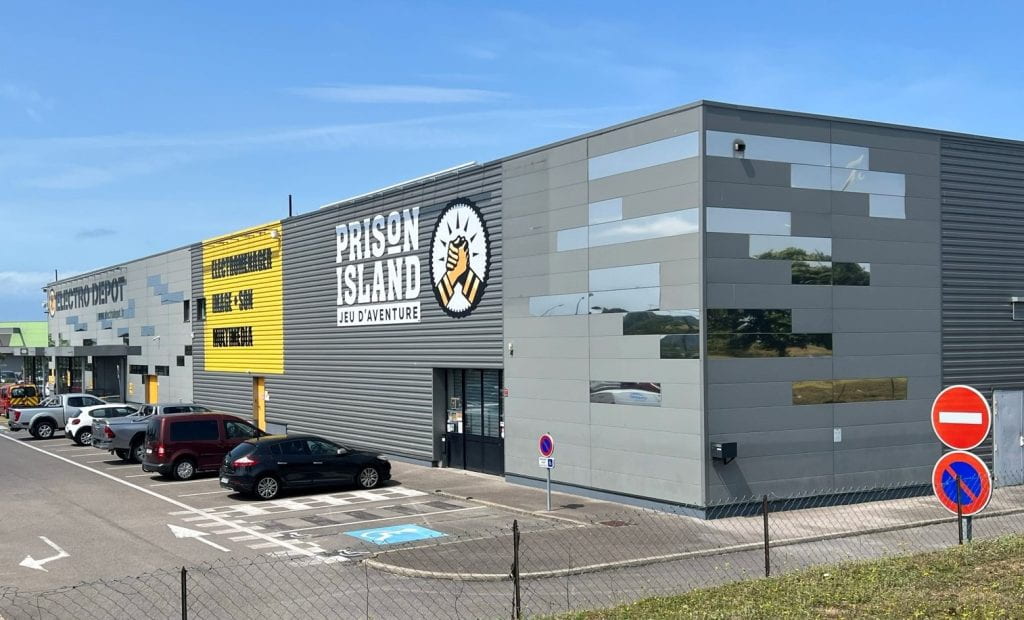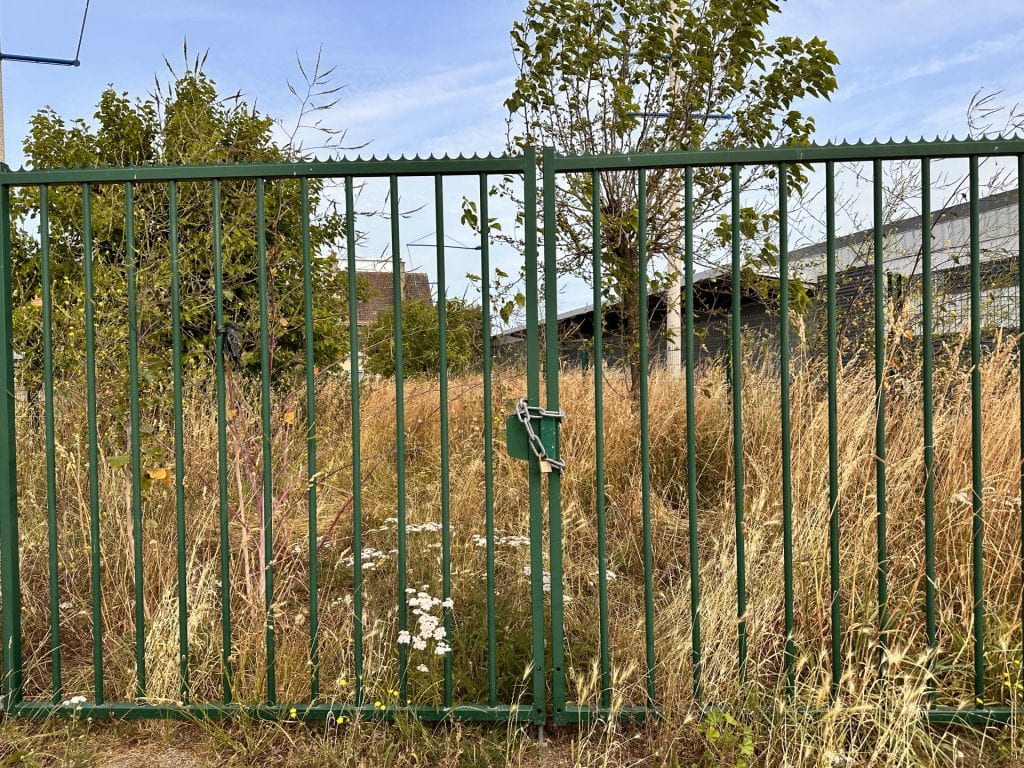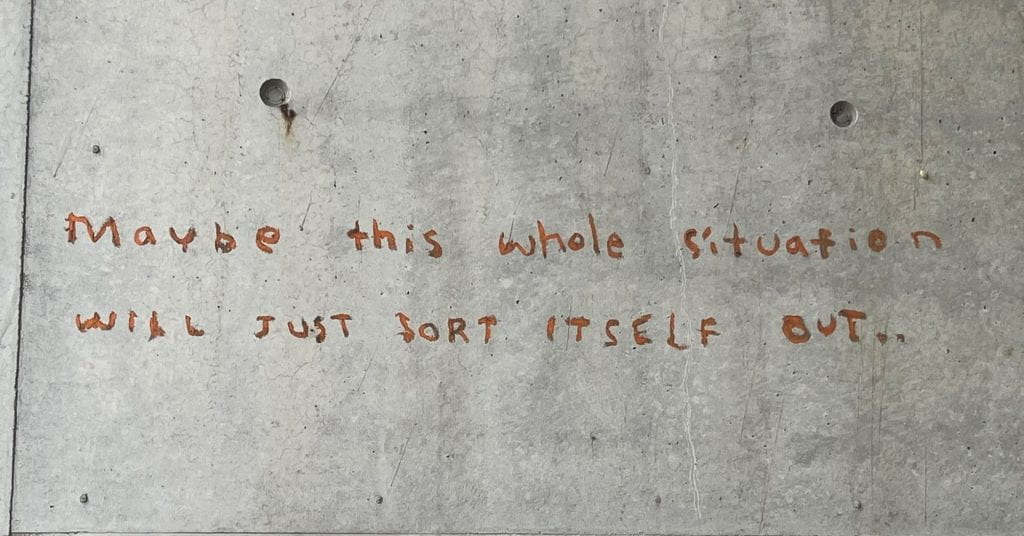Borderland Infrastructures – an MMB special series exploring the material and symbolic infrastructure of border regimes in the port cities of Calais and Dover.
By Bridget Anderson.
As we walked around Calais, one of the group remarked ‘It’s just like The City & the City!’ She was spot on. In his novel The City & the City (2009), China Miéville describes a murder investigation that takes place in what, from the outside, looks like one city, but is for its residents two, Besźel/Ul Qoma, which occupy the same space. From childhood, citizens of one are taught to ‘unsee’ the residents, buildings and events of the other. Ignoring or accidentally forgetting this separation is called ‘breaching’, a crime worse than murder. Calais is a manifestation of this hallucinatory dystopia. It is both seaside town and bidonville, both tourist trap and migrant hub. The seaside town markets itself with a certain irony (maybe particularly appreciated by a British sensibility) as ‘Calaisfornia’. In the shopping mall that borders Calais’ Channel Tunnel terminal there is an escape room called the Prison Island adventure game. The escape room backs onto the border police station and an immigration detention centre. To comfortably inhabit Calais(fornia) it is necessary to see past exclusion and violence, and to accept brutal immigration enforcement as a minor inconvenience.

In July 2023, the MMB team, Challenge leads and Leverhulme Visiting Professor Victoria Hattam, of the New School for Social Research, visited Calais. We were guided by a long-term activist and researcher who has been working in the town for over ten years. It was his knowledge and experience that enabled us to commit a ‘breaching’ and see the gaps between the cities. Calais(fornia) is crosshatched (Miéville fans will catch the analogy) with fences and barbed wire. For Calais(fornia) visitors, they enclose random spaces: running along both sides of a long, thin strip of disused yard; closing off a space under a bridge; enclosing a small piece of land in front of some residential flats. Indeed, the randomness helps invisibilise the practice: there is nothing of note here, nothing exciting or dangerous that is guarded by these fences, just concrete and grass. But breaching enabled us to see these spaces were once hubs where people on the move gathered, hosting community kitchens, they were meeting and distribution points, places where people could sleep. In January 2015, when people were forcibly evicted from the centre of Calais and pushed to the outskirts of the city, the spaces they vacated were enclosed to ensure that they could not be used again. The fences can be read as maps of struggles against deportation and eviction.

These evictions were the origin of the so-called Jungle* as people were pushed to a piece of land that had been a neglected dump for city rubbish, toxic waste and dredgings from the port expansion (Van Isacker 2022). This became the gathering point for people attempting to cross from France to the UK and was a constant source of dispute for the two governments. In October 2016, the French Government destroyed the encampment completely and declared the area subject to ‘ecological restoration’ and ‘landscape reconquest’. It was converted into a nature reserve, with the UK Home Office a key investment partner. The topography was changed to make it attractive to waterfowl but impossible for humans to camp on, and anti-intrusion features made it difficult for humans to traverse. ‘Fort Vert’ was transformed into a reserve where the citizens of Calais could ‘reconnect’ with nature and where the endangered native species Liparis Loeselii fen orchid could flourish. This would mean the space could achieve designated status in France’s ‘National Restoration Plan’. The then UK Immigration Minister was delighted, describing the project as facilitating a ‘return to nature’ and as preventing the return of migrants to the area (Rullman 2020). This eerily silent space is a different form of enclosure. But it is haunted by its recent past: the police access road, the fences around the motorway, the graffiti under the bypass declaring ‘No Border No Nation’ and, in a nod to Calais(fornia), ‘Maybe this whole situation will just sort itself out…’. People on the move today are banished largely to the inhospitable territory of the outskirts, with no easy access to basic necessities like water, food or shops.

Calais(fornia) is curiously manicured and carefully landscaped. Flowers and grasses abound, but bushes have been uprooted as they provide shelter. We roamed freely around Calais(fornia), and about halfway through our walk we arrived at the town hall, a striking red brick and stone building constructed in the early twentieth century and surrounded by well-tended flower beds and grass. One of the group took a photograph of us as we sat down and opened our map to decide next steps. To sit freely should not be taken for granted. After the eviction of 2016 the authorities announced a policy of ‘zero point de fixation’, moving people on within hours to ensure that there is no possibility of informal settlements, destroying tents and goods in processes known as ‘cleaning’. As part of this policy green spaces which could be potential resting spaces are littered with boulders to prevent people from lying down or gathering. As we walked past one such space, I wondered what purposes future archaeologists might attribute to these out-of-place rocks that must have taken such efforts to move and that make public spaces so horribly ugly and unusable. A form of worship? A collective project that builds community? Will such cruelty and racism be imaginable?

We, the breachers, both sat and moved freely. The thousands of people on the move who attempt to breach the national border that separates Britain and France enjoy no such possibility. To be able to inhabit Calais(fornia) and to see Calais is indeed a privileged position. But I left feeling the importance of not being paralysed or silenced by that acknowledgment of privilege. Rather, having seen, we now have a responsibility to speak.
* There are in fact many ‘jungles’ around Calais, but this site is the one most strongly associated with the word.
Bridget Anderson is the Director of Migration Mobilities Bristol (MMB) and Professor of Migration, Mobilities and Citizenship in the School for Sociology, Politics and International Studies at the University of Bristol.
Other MMB blogs and projects connected to this post include the (de)Bordering plot, a space for exploring the politics of immigration and the environment through planting, which contains a Hearth modelled on shelters in the Calais ‘Jungle’. See also Travis Van Isacker’s post on ‘Environmental racism in the borderland: the case of Calais’ analysing how the French and UK governments have created a hostile environment for migrants trying to cross the Channel from Calais.

